

Johns Hopkins University (JHU) continues to pad its space community résumé with their interactive map, “The map of the observable Universe”, that takes viewers on a 13.7-billion-year-old tour of the cosmos from the present to the moments after the Big Bang. While JHU is responsible for creating the site, additional contributions were made by NASA, the European Space Agency, the National Science Foundation, and the Sloan Foundation.

Milky Way centre by the MeerKAT array of 65 radio dishes in South Africa. The image spans 4 times the Moon’s size in the sky. Ian Heywood (Oxford U.), SARAO; Here is a full sized version of the picture that was posted in Astronomy Picture of the Day. Colour processing on the image was done by Juan Carlos Munoz-Mateos (ESO) whose Instagram channel you should definitely check out. Has some of the coolest astro images I’ve seen.

Another version of the MeerKAT image of the Galactic centre Credit: I. Heywood, SARAO

Numerous filaments spanning the Galactic plane. The filaments are identified in the lower panel “Spectral Index” Credit Heywood et al Figure 9

This cirrus cloud-like emission from the Galactic centre super bubble dominates this image. This is traversed by a complex of many parallel filaments. The radio bubble nestles against the diffuse Sagittarius A region in the lower centre of the image. The bright dot near the centre of this region is Sagittarius A*, a 4 million solar mass black hole. This image captures the chaotic complexity of the very heart of our Galaxy. Credit: I. Heywood, SARAO Image Description SARAO
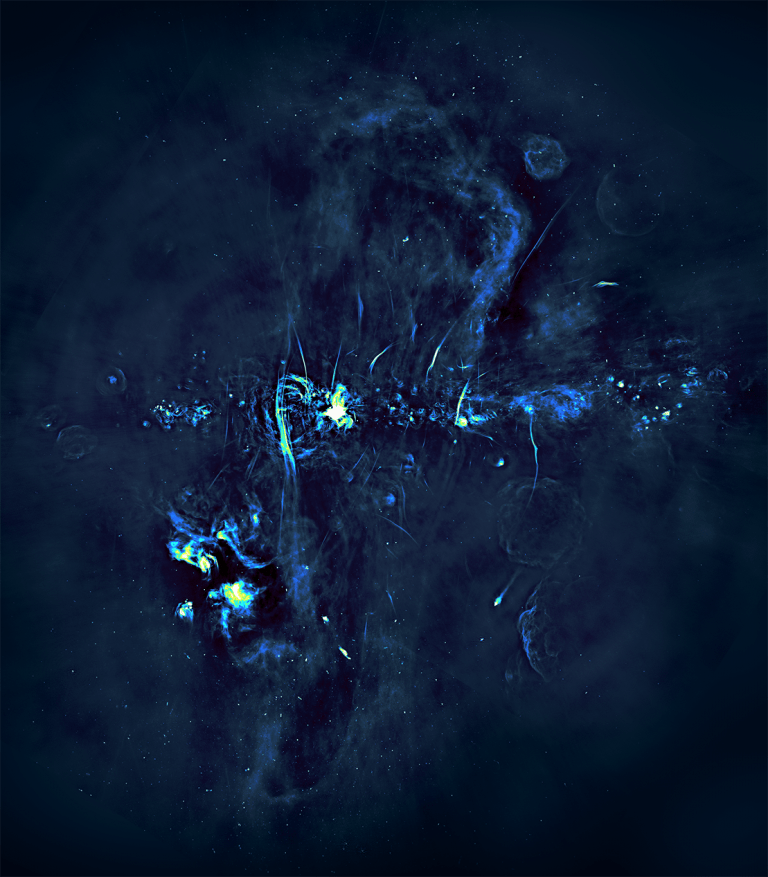
The “hour glass” radio bubbles discovered by MeerKAT extend vertically above and below the plane of the galaxy. Many magnetised filaments can be seen running parallel to the bubbles. (Adapted from results published in Heywood et al. 2019.).

Researchers used a new technique to transform 2D radio images into a 3D model to better understand phenomena in our Universe. Credit: Lawrence Rudnick/MeerKAT Radio Telescope
University of Minnesota College of Science and Engineering Professor Lawrence Rudnick developed an animation that depicts the 3D structure of jets of charged particles emerging at high speeds from a supermassive black hole, showing how they appear from different angles as we rotate our view from front-to-side and back. Credit: Rudnick Group, University of Minnesota
As soon as you learn about the supermassive black hole at the center of the Milky Way, your next thought is: is that thing going to destroy our galaxy? In the short term, no, in the long term… maybe? Universetoday's youtube channel Sign up to my weekly email newsletter: Weekly Space Hangout: Astronomy Cast: Support us at:Support us at: Follow us on Tumblr: More stories at ---------------------------------------------------------------------- Follow us on Twitter: @universetoday Like us on Facebook: Instagram - Support us at:Support us at: Instagram - Team: Fraser Cain - @fcain / frasercain@gmail.com /Karla Thompson - @karlaii Chad Weber - Chloe Cain - Instagram: @chloegwen2001 Music: Left Spine Down - “X-Ray” Team: Fraser Cain - @fcain / frasercain@gmail.com Karla Thompson - @karlaii / Karla Thompson's youtube channel Chad Weber - weber.chad@gmail.com Chloe Cain - Instagram: @chloegwen2001 Music: Left Spine Down - “X-Ray”

Catalogue of newly discovered filaments from MeerKAT. Credit Heywood et al Fig 8

A rare, almost-perfect spherical supernova remnant that has been discovered at the edge of the MeerKAT mosaic. Numerous compact radio sources are also visible, many of which signpost supermassive black holes at the centres of galaxies far beyond our own. There is also an intriguing tailed radio source visible on the right of the image, which could be an object in our galaxy moving at high speed, leaving a trailing wake. Credit: I. Heywood, SARAO. Image Description by SARAO

The upper panel’s glowing area shows a synchrotron radiation halo surrounding the supermassive black hole at the centre of the galaxy. The radiation highlights the flows of gas funneling toward the black hole. As the gas approaches the black hole, it is heated beginning to ionize where electrons are stripped from the gas. The ionized gas appears as a “mini-spiral” in the lower panel within about five light years of the central black hole. The scale on the top panel shows 5pc (parsecs or about 16 light years). In other words, this cloud of ionized gases and synchrotron radiation swirling about our black hole is light years across. Credit Heywood et al Figure 14

Karl Jansky’s radio telescope build to rotate on Ford Model-T wheels. This is the first radio telescope ever created. Image courtesy of NRAO CC by 3.0

MeerKAT observatory Credit SARAO

Are there civilizations somewhere else in the Universe? Somewhere else in the Milky Way? That’s one of our overarching questions, and an answer in the affirmative would be profound.

Are there civilizations somewhere else in the Universe? Somewhere else in the Milky Way? That’s one of our overarching questions, and an answer in the affirmative would be profound.
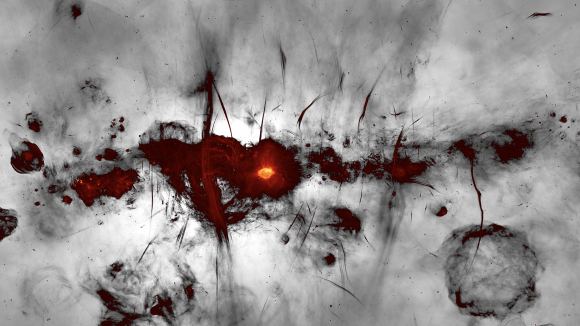
The new MeerKAT image of the Galactic centre region is shown with the Galactic plane running horizontally across the image. Many new and previously-known radio features are evident, including supernova remnants, compact star-forming regions, and the large population of mysterious radio filaments. Colours indicate bright radio emission, while fainter emission is shown in greyscale. Credit: I. Heywood, SARAO. Image description: SARAO

his image shows a portion of the electromagnetic spectrum focusing on radio waves. Image Credit: NASA

A simple schematic of the Milky Way. Image Credit:, By RJHall at English Wikipedia, CC BY-SA 3.0

An artist view of a highly magnetized neutron star. Planets too close to a magnetar would face a magnetic field one trillion times stronger than Earth’s. Magnetars emit extremely powerful xrays and gamma rays which would render life impossible in their vicinity. Credit: Carl Knox/ OzGrav
This video sequence zooms into the Hubble Space Telescope view of the galactic core. Hubble's infrared vision pierced the dusty heart of our Milky Way galaxy to reveal more than half a million stars at its core. Except for a few blue, foreground stars, the stars are part of the Milky Way's nuclear star cluster, the most massive and densest stellar cluster in our galaxy. Located 27,000 light-years away, this region is so packed with stars, it is equivalent to having a million suns crammed into the volume of space between us and our closest stellar neighbor, Alpha Centauri, 4.3 light-years away. At the very hub of our galaxy, this star cluster surrounds the Milky Way's central supermassive black hole, which is about 4 million times the mass of our sun.
People are always worried that alien civilizations will detect the transmissions from our old radio shows and television broadcasts, and send in the invasion fleet. But the reality is that life itself has been broadcasting the existence of life on Earth for 500 million years. Blame it on the plants. In addition to filling the atmosphere with oxygen, plants give off a very specific wavelength visible in infrared radiation. It’s the kind of signal that other civilizations could search for as they’re scanning the galaxy. It’s what we’ll be looking for too. But don’t just blame the plants. Other forms of life have been giving off signals too, signals we can search for as we discover new exoplanets and wonder if they have life there. Information on ESA's ARIEL mission Audio Podcast version: : ITunes RSS: What Fraser's Watching Playlist: Weekly email newsletter: Universetoday's youtube channel Sign up to my weekly email newsletter: Weekly Space Hangout: Astronomy Cast: Support us at:Support us at: Follow us on Tumblr: More stories at ---------------------------------------------------------------------- Follow us on Twitter: @universetoday Like us on Facebook: Instagram - Support us at:Support us at: Instagram - Team: Fraser Cain - @fcain / frasercain@gmail.com /Karla Thompson - @karlaii Chad Weber - Chloe Cain - Instagram: @chloegwen2001 Music: Left Spine Down - “X-Ray” Team: Fraser Cain - @fcain / frasercain@gmail.com Karla Thompson - @karlaii / Karla Thompson's youtube channel Chad Weber - weber.chad@gmail.com References: A search for life on Earth from the Galileo spacecraft from Nature magazine Asteroid-bound spacecraft finds signs of life—on Earth Expanding the Timeline for Earth’s Photosynthetic Red Edge Biosignature (PDF) Exoplanet evolution: Astronomers expand cosmic ‘cheat sheet’ Vegetation’s Red Edge: A Possible Spectroscopic Biosignature of Extraterrestrial Plants (PDF) . GRAVITY Instrument Breaks New Ground in Exoplanet Imaging Cutting-edge VLTI instrument reveals details of a storm-wracked exoplanet using optical interferometry ARIEL SPACE MISSION European Space Agency M4 Mission

On April 10th, 2019, the international consortium known as the Event Horizon Telescope (EHT) announced the first-ever image of a supermassive black hole (SMBH). The image showed the bright disk surrounding the black hole at the center of the M87 galaxy (aka. Virgo A). In 2021, they followed up on this by acquiring an image of the core region of the Centaurus A galaxy and the radio jet emanating from it. Earlier this month, the European Southern Observatory (ESO) announced that the EHT would be sharing the results from its latest campaign – observations of Sagittarius A*!
May 12, 2022 The Event Horizon Telescope has released the first image of the supermassive black hole Sagittarius A*, which is located in the Milky Way.

The Atacama Large Millimeter/submillimeter Array (ALMA) looking up at the Milky Way and the location of Sagittarius A*, the supermassive black hole at our galactic center. Credit: ESO
May 12, 2022 What does it take to capture an image of the black hole at the centre of our galaxy? This video explains how the Event Horizon Telescope (EHT) works, and how astronomers managed to create one massive Earth-sized telescope big enough to “see” at the edge of black holes.
May 12, 2022 While they may look similar, the two black holes imaged by the Event Horizon Telescope (EHT) Collaboration are actually very different. Sagittarius A* (Sgr A*), the black hole at the centre of the Milky Way, is over a thousand times smaller than the black hole at the centre of the galaxy M87. The reason they appear the same size is because of their relative distances from Earth. This animation demonstrates their massive differences in size by showing what the M87 black hole would look like if it were closer to Earth. The final frame shows the sizes of the two black holes if they were both at the same distance from Earth as Sgr A*.
May 12, 2022 Watch as this video sequence zooms into the black hole (Sgr A*) at the centre of our galaxy. Beginning with a broad view of the Milky Way, we dive into the dense clouds of gas and dust at our galactic centre. The stars here have been observed with ESO’s Very Large Telescope and ESO’s Very Large Telescope Interferometer for decades, the black hole’s immense gravitational pull distorting the orbits of the stars closest to it. Finally, we arrive at Sgr A*, the first image of which has been captured by the EHT collaboration. The black hole is shown by a dark central region called a shadow, surrounded by a ring of luminous gas and dust. The various observations used here were taken at different times, by different teams and with different facilities, and put together for the purpose of the zoom effect. The images go from visible wavelengths at the beginning to infrared, with the very final image being taken at radio wavelengths. Credit: ESO/L. Calçada, N. Risinger (skysurvey.org), DSS, VISTA, VVV Survey/D. Minniti DSS, Nogueras-Lara et al., Schoedel, NACO, GRAVITY Collaboration, EHT Collaboration (Music: Azul Cobalto) This video is available for download (various formats including Ultra HD) on:
Astronomers have just found the fastest star (S4716) with the shortest orbital period EVER found, around the Sagittarius A* supermassive black hole. And it's intense. : Source The Astrophysical Journal Watch Stars Move Crazy Fast Around Supermassive Black Hole (VIDEO): Join this channel to get access to perks: / @cosmoknowledge SUBSCRIBE ► ---- Website ► Facebook ► Instagram ► Twitter ► Produced & Edited by: Ardit Bicaj Narrated by: Russell Archey Graphics: Space Engine MPE TWENTYTWO Film ESO L. Calçada GRAVITY collaboration Stock footage: envato.com iStock.com/ /Schroptschop /Srinivasan J /Gaf-1977 /voshadhi Music: ES_Guardians - Dream Cave Bonfire - An Jone Licenses used: A big thank you to our lovely channel members: Joseph Pacchetti Damon Reid - Cosmoknowledge brings news from space. We love you, explorers!

There’s a population of stars in the heart of our galaxy whipping around Sagittarius A* (the Milky Way’s central supermassive black hole). Astronomers just found the closest, fastest one (so far). It’s called S4716 and it orbits Sag A* once every four years. That makes it officially the fastest star moving at the heart of our galaxy. To give you some perspective, the Sun moves around the center of the galaxy at a much more leisurely pace once every 230 million years.

The K-band (near-infrared) view of the GC observed with NIRC2 (Keck) in 2019.30. This image is high-pass filtered and shows the position of several S stars close to Sgr A*, which is indicated by a black cross. Note that the newly discovered S4716 (lime green elliptical orbit) is the smallest and closest to Sgr A*. Here north is up and east is to the left. Credit: The Astrophysical Journal (2022). DOI: 10.3847/1538-4357/ac752f

False-color image of the region Sagittarius B1, as seen by the GALACTICNUCLEUS survey. Credit & ©: F. Nogueras-Lara et al. / MPIA

This is an image of the center of the Milky Way. The bright white area right of center is home to the supermassive black hole Sagittarius A star. Credit: By NASA/JPL-Caltech/ESA/CXC/STScI

The central region of the Milky Way in infrared light, acquired by NASA’s Spitzer Space Telescope. Credit: NASA/JPL-Caltech/S. Stolovy (Spitzer Science Center/Caltech)

The all-sky view that the Gaia survey would have of a simulated Milky-Way-like galaxy. Credit: Sanderson et a

The Atacama Large Millimeter/submillimeter Array (ALMA) looked at Sagittarius A*, (image of Sag A* by the EHT Collaboration) to study something bright in the region around Sag A*. Credit: ESO/José Francisco Salgado

This shows a still image of the supermassive black hole Sagittarius A*, as seen by the Event Horizon Collaboration (EHT), with an artist’s illustration indicating where the modeling of the ALMA data predicts the superheated blob of gas to be and its orbit around the black hole. Credit: EHT Collaboration, ESO/M. Kornmesser (Acknowledgment: M. Wielgus)

Imagery from NASA’s Imaging X-ray Polarimetry Explorer and Chandra X-ray Observatory have been combined to show X-ray data of the area around Sagittarius A*, the supermassive black hole at the core of the Milky Way galaxy. The lower panel combines IXPE data, in orange, with Chandra data in blue. The upper panel depicts a much wider field-of-view of the center of the Milky Way, courtesy of Chandra. The thin white lines layered onto the top panel frame the highlighted area, and indicate that the perspective in the bottom panel has been rotated approximately 45 degrees to the right. The combination of IXPE and Chandra data helped researchers determine that the X-ray light identified in the molecular clouds originated from Sagittarius A* during an outburst approximately 200 years ago. Credits: IXPE: NASA/MSFC/F. Marin et al; Chandra: NASA/CXC/SAO; Image Processing: L.Frattare, J.Major & K.Arcand

A time-lapse movie in infrared light detailing how stars in the central light-year of our Galaxy have moved over a period of 14 years. The yellow mark at the image center represents the location of Sgr A*. Credit: A. Eckart (U. Koeln) & R. Genzel (MPE-Garching), SHARP I, NTT, La Silla Obs., ESO
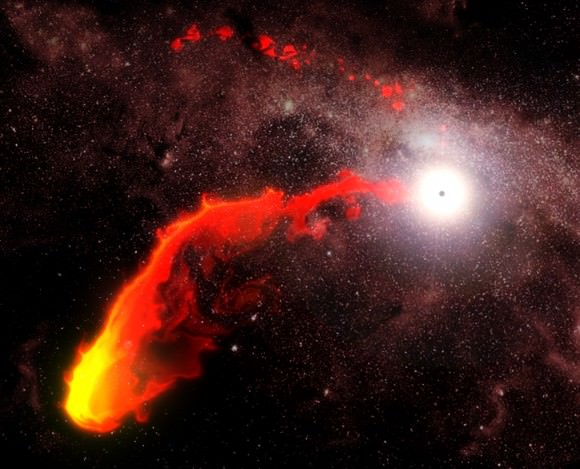
Illustration of gas cloud G2 approaching Sgr A*. Our central supermassive black hole periodically snacks on clouds and other materials like this. That gives off X-rays and other emissions. (ESO/MPE/M.Schartmann/J.Major)
Combined images of Sagittarius A*, the supermassive black hole at the center of the Milky Way galaxy, enabled researchers to develop a sonification, or an adaptation of visual information into audible, even musical sounds. In this sonification, adapting data from NASA’s Imaging X-ray Polarimetry Explorer and Chandra X-ray Observatory, an arched line ripples across the image, starting at the lower righthand corner. As it passes over the orange-tinted IXPE data, sounds like digital winds are triggered, particularly where those orange areas are brightest. When the traveling line passes the blue-tinted Chandra data, the resulting notes resemble steel drums. #nasa #shorts #sonification #spacesounds #blackhole
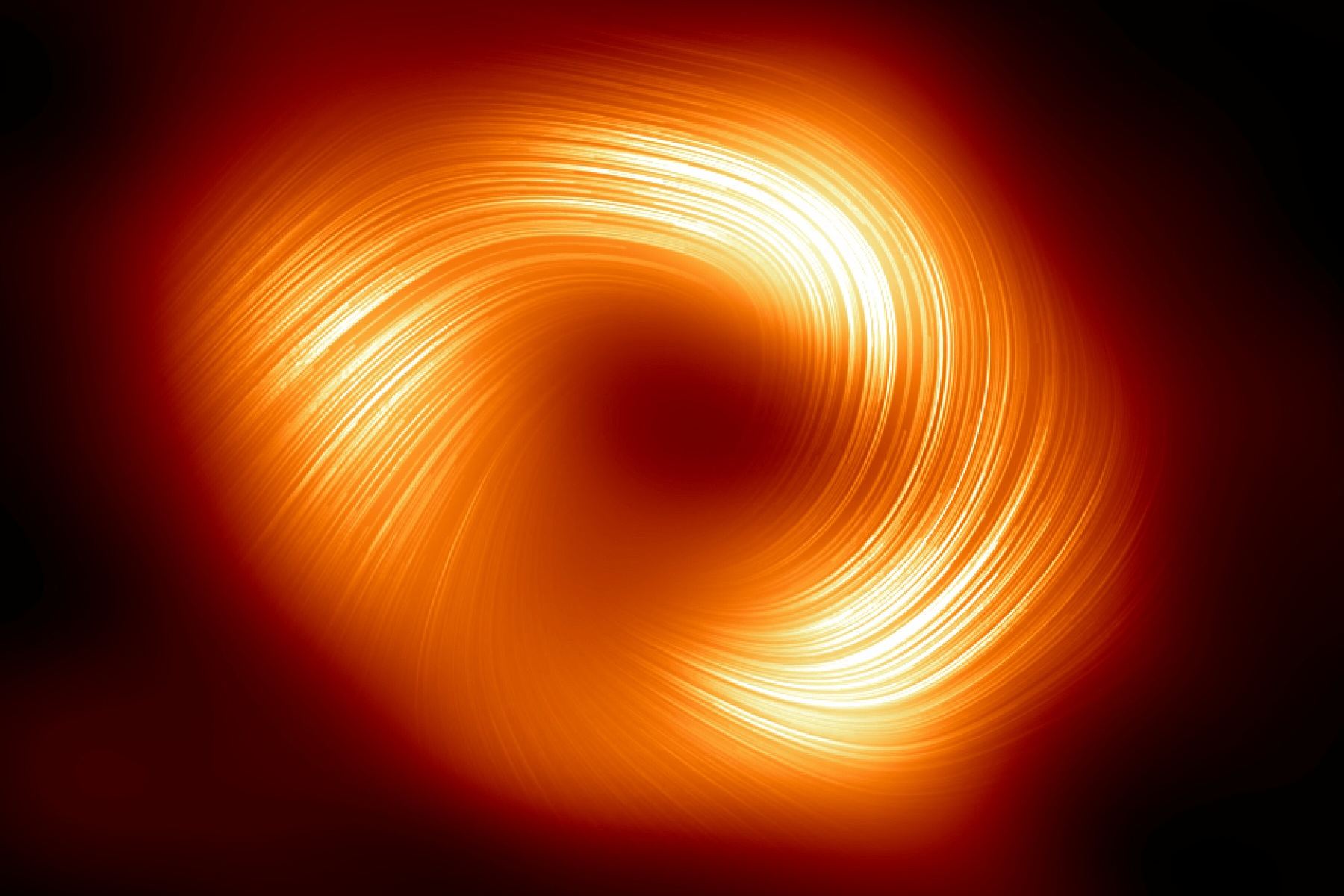
A new image from the Event Horizon Telescope shows lines of polarization, a signature of magnetic fields, around the shadow of the Milky Way's central black hole. (Credit: EHT Collaboration)
Black holes are enveloped in plasma. This plasma has magnetic fields—areas where magnetism affects how matter moves—threaded throughout. As the magnetic field grows stronger, it changes shape and the polarized light we measure exhibits different patterns. Today, we reveal the polarized image of Sagittarius A*. It looks very similar to our previous image of M87*! This magnetic field strength has a powerful influence on how objects orbit the black hole and on the formation of black hole jets, which is one of the greatest mysteries in modern astronomy. The Event Horizon Telescope (EHT) is an international collaboration that captured the first image of a black hole by creating a virtual Earth-sized telescope. To learn more, you can check out our website at If you enjoyed this video, please like, comment, and subscribe! Credit: Producer: Smithsonian Astrophysical Observatory Director: Angelo Ricarte, Sara Issaoun Writers: Angelo Ricarte, Sara Issaoun Editors: Angelo Ricarte, Sara Issaoun Black Hole Image: EHT Collaboration Narrator: Christopher Gaal Animation: Crazybridge Studios Animation Director: Christopher Gaal 3D Animator: Scott Bell

A computer simulation of the disk of plasma around M87’s supermassive black hole shows how magnetic fields help launch jets of matter at near the speed of light. Scientists say the Milky Way’s black hole appears to be doing something similar. (Credit: George Wong/ EHT)
It’s Black Hole Week! The journey to capture an image of a black hole is not an easy one. Learn about the challenges the Event Horizon Telescope has overcome to see the unseeable! ---------- The Event Horizon Telescope (EHT) is an international collaboration that captured the first image of a black hole by creating a virtual Earth-sized telescope. To learn more, you can check out our website at . : Follow us on Twitter Or follow us on Instagram: ---------- Credits: Animation: Chris Jones ) Screenplay: Smithsonian Astrophysical Observatory ) ) Edits: Sara Issaoun ) Transcript
Light is an oscillating electromagnetic wave. If the waves have a preferred direction of oscillation, they are polarized. In space, moving hot gas, or ‘plasma’, threaded by a magnetic field emits polarized light. The polarized light rays that manage to escape the pull of the black hole travel to a distant camera. The intensity of those light rays and their direction are what we observe with the Event Horizon Telescope. Today, we reveal a breakthrough discovery: the Event Horizon Telescope has imaged polarized light close to the shadow of Sagittarius A* for the very first time. Using this knowledge, we can map out the magnetic fields that surround the black hole, and connect them to the powerful jet of plasma it ejects. The Event Horizon Telescope (EHT) is an international collaboration that captured the first image of a black hole by creating a virtual Earth-sized telescope. To learn more, you can check out our website at If you enjoyed this video, please like, comment, and subscribe! Credit: Producers: Radboud University, Goethe University Frankfurt Director: Sara Issaoun Writers: Sara Issaoun, Monika Moscibrodzka, Raquel Fraga Encinas, Christiaan Brinkerink, Hector Olivares, Freek Roelofs Editors: Sara Issaoun, Raquel Fraga Encinas, RU EHT Group, Polarimetry Working Group, and Outreach Working Group Narrator: Nicola Barber Animation: Fiks Film Animation Director: Nelis Claassen Funded with support from the European Research Council, Radboud University Nijmegen, and Goethe University Frankfurt. Realised under the auspices of the Event Horizon Telescope.
Polarization allows us to tell apart images that would otherwise look very similar! Here we examine two simulations from the Event Horizon Telescope (EHT) collaboration library, and show how both linear and circular polarization give us insights into the plasma conditions. We use these clues to figure out how black holes grow and power jets. The Event Horizon Telescope (EHT) is an international collaboration that images black holes with polarization by creating a virtual Earth-sized telescope. To learn more, you can check out our website at If you enjoyed this video, please like, comment, and subscribe! Credit: Producer: Smithsonian Astrophysical Observatory Director: Angelo Ricarte Writers: Angelo Ricarte Editors: Angelo Ricarte, Sara Issaoun Simulations: Angelo Ricarte, Abhishek Joshi, Ben Prather, EHT Collaboration Narrator: Christopher Gaal, Crazybridge Studios
I hope you enjoy this SUPERMASSIVE Easter gift!! #space #nasa #blackhole Please support my trip to Space Symposium! EARLY VIDEO RELEASES, DISCORD MEMBERSHIP AND EXCLUSIVE CONTENT PLUS 15% OFF MERCH! Support the Angry Astronnaut on patreon Support the Angry Astronnaut on Pay Pal : Follow me on twitter
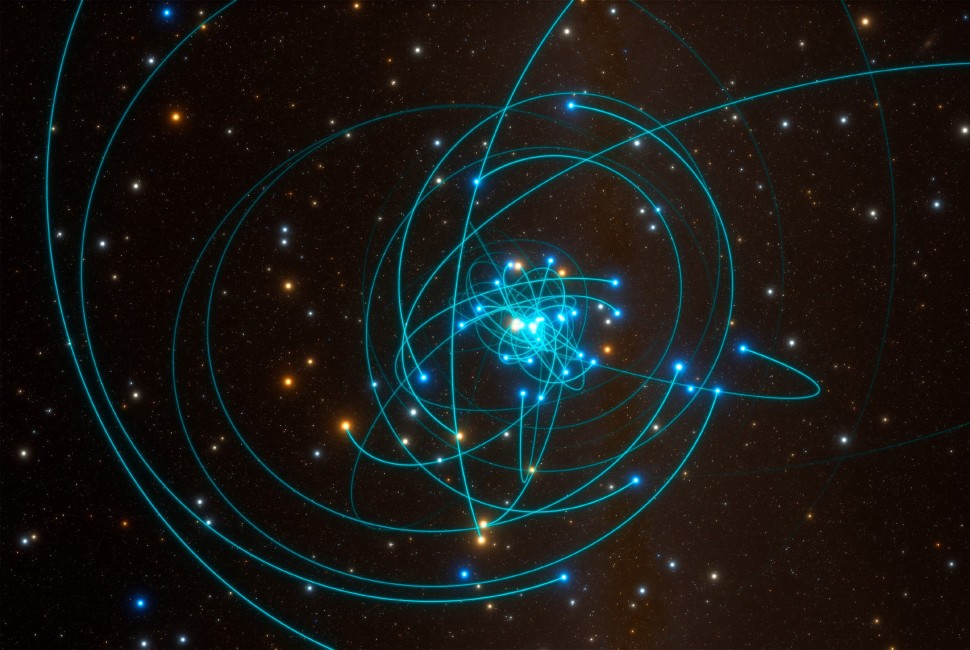
This illustration shows stars orbiting close to the Milky Way's central supermassive black hole. The black hole accelerates stars nearby and sends them crashing into one another. Credit: space engine ESO/L. Calçada/

The Milky Way galaxy hosts a supermassive black hole (Sgr A*, shown in the inset on the right) embedded in the Nuclear Star Cluster (NSC) at the center, highlighted and enlarged in the middle panel. The image on the right shows the stellar density in the NSC. Image Credit: Zhuo Chen

X7 is an elongated gas and dust structure in the galactic centre. The researchers suggest it could be made of mass stripped from stars during collisions between fast-moving stars near Sgr. A*. G3 and G2 are objects that resemble clouds of gas and dust but also have properties of stellar objects. Image Credit: Ciurlo et al. 2023.

This artist’s illustration shows a massive star orbiting Sagittarius A*. Post-collision, some stars gain mass and end up shortening their lives. Image Credit: University of Cologne

X-Ray Data Revealing Jets at the Center of the Milky Way Credit: X-ray: NASA/CXC/Univ. of Chicago/S.C. Mackey et al.; Radio: NRF/SARAO/MeerKAT; Image Processing: NASA/CXC/SAO/N. Wol

Artist’s illustration of Chandra Using the power of the Chandra telescope to study the centre of our Galaxy, ridges that were perpendicular to the plane of the Milky Way were seen at a distance of 26,000 light years. The team of researchers believe the ridges are the walls of a tunnel that is shaped like a cylinder. The structure helps to funnel hot gas along, much as a chimney does over a fireplace, and away from the centre of the Galaxy. The vent is about 700 light years long and extends away from the core of the Milky Way.

The diagonal line of bright objects in this image of the heart of our Milky Way Galaxy are all powerful sources of radio waves. The bright center is the home of the supermassive black hole, Sagittarius A*. The dense, bright circles are the nurseries of new, hot stars and the bubbles are the graveyards of exploded, massive stars. The thread-like shapes are not yet understood, but probably trace powerful magnetic field lines. This giant image was assembled from observations made by the Very Large Array (VLA).
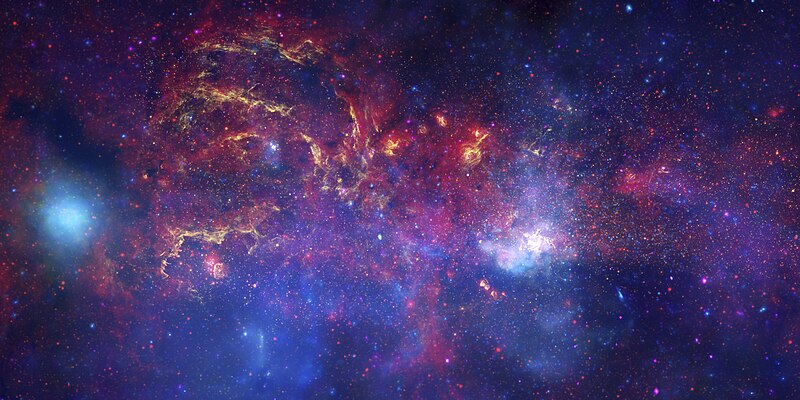
Image of the galactic center, including Sgr A* Credit – NASA/JPL-Caltech/ESA/CXC/STSci
Blue dots: S stars and their related orbital motion Red dots: Dusty objects and their related orbital motion The supermassive black hole Sgr A* is located at (0/0) Please see the related press release of the University of Cologne: The paper (open access!) can be found here: In this paper, we inspect the individual orbits of a dozen dusty objects. Some authors believed that these objects are core less dust clouds that orbit the supermassive black hole with a mass of 4 million times the mass of the sun. While this scenario was highly unlikely even at the time when it was proposed, we show in the current study that this idea can be debunked due to heating mechanisms that would destroy and evaporate any cloud in the high energetic radiation environment of Sgr A*. Interestingly, all investigated sources show signatures of Young Stellar Objects. Although it is not clear how these objects ended up in the direct vicinity of Sgr A*, they orbit the supermassive black hole in a specific pattern. This unexpected becomes even more mysterious by taken into account the stars, that reside in the same environment. The so called S stars are believed to be arranged around Sgr A* in two disks. The here discussed dusty sources are associated with one of these disks suggesting several scenarios: is there an age gradient between the disks? Considering that a spinning black hole alters the orbits of any object in its vicinity, we can put an upper limit on these timescales. What one would expect is a random orientation of the objects due to the spinning space time curvature (Lense Thirring effect). This is not what we find. Hence, the must have migrated towards Sgr A* "recently".
Support us at:Support us at: Patreon More stories at 🚀 OTHER SOCIAL MEDIA: Frasiser Cain's Twitter: Universetoday's Twitter: Facebook: Instagram: Team: Fraser Cain - @fcain Jason Harmer - @jasoncharmer Chad Weber - weber.chad@gmail.com Created by: Fraser Cain and Jason Harmer Edited by: Chad Weber Music: Left Spine Down - “X-Ray” •Left Spine Down - Side Effect (new track 2014)

A far-infrared Herschel image of our Galaxy’s Central Molecular Zone (CMZ) reveals a bright and dense ring of molecular gas and dust encircling our supermassive black hole, SgrA*.

Illustration of the Milky Way (Credit : NASA/JPL-Caltech/R. Hurt)
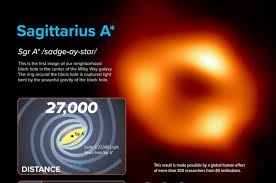
Sagittarius A* imaged by the Event Horizon Telescope in 2017 (Credit : EHT Collaboration)

Top panel: HiGAL column density map of the CMZ.from Phys.org

A detailed infrared view of the Galactic Center region of our Milky Way Galaxy. Sgr B1 and B2, and Sgr C are the three star-forming regions studied in the research. For some reason, they struggle to form massive stars. Image Credit: J. De Buizer (SETI) / SOFIA / Spitzer / Herschel.

This figure from the research shows Sgr B1 and B2. MYSOs are marked in letters and numbers. Letters represent MYSOs identified as radio continuum sources and numbers represent MYSOs identified as infrared sources. Image Credit: De Buizer et al. 2025. The Astrophysical Journal.

This figure shows Sgr C and its three sub-regions. The numbers indicate MYSO candidates identified by SOFIA. Image Credit: De Buizer et al. 2025. The Astrophysical Journal.*
The center of our Galaxy is a mystery. It is full of dust which most telescopes can't see through. But with James Webb we can look into it. What hides deep in the middle of the Milky Way? Finding out with Dr Adam Ginsburg. 👉 Dr Adam Ginsburg's website: 👉 JWST reveals widespread CO ice and gas absorption in the Galactic Center cloud G0.253+0.015 Support us at:Support us at:Patreon 📚 Suggest books in the book club: / universe-today-book-club 00:00 Intro 01:27 Skies at the center of the Milky Way 05:31 Using JWST to see our galaxy 07:07 What is there to learn 19:49 How different is the center 24:50 How to get better results 29:52 What's next 📰 EMAIL NEWSLETTER Read by 60,000 people every Friday. Written by Fraser. No ads. Sign up to my weekly email newsletter: For Free 🎧 PODCASTS Universe Today: Astronomy Cast: 🤳 OTHER SOCIAL MEDIA Frasiser Cain's Twitter: Universetoday's Twitter: Facebook: Instagram: 📩 CONTACT FRASER CONTACT FRASER: via Email: